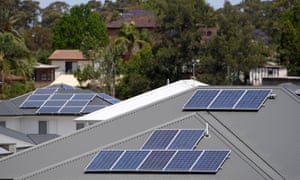Extract from The Guardian
ANU research suggests net cost of achieving Paris targets is zero because renewables are now cheaper than fossil fuels
New research finds Australia is installing renewable energy faster
than any other country, a trend that will allow Australia to meet its
economy-wide Paris targets five years ahead of schedule if politics
doesn’t derail the trend, according to new research from the Australian
National University.
While emissions have been rising across the economy since the Abbott government repealed the carbon price after winning government in 2013, they have been falling in the electricity sector because of the closure of ageing coal plants and the rapid uptake of renewables.
The lead researcher, ANU professor Andrew Blakers, says Australia is currently installing renewable power four or five times per capita faster than the European Union, Japan, China and the United States. That finding is based on preliminary data available for installations globally last year.
Blakers says that trend is expected to continue, unless politics intervenes. “The electricity sector is on track to deliver Australia’s entire Paris emissions reduction targets five years early, in 2025 – without the need for any creative accounting,” he says.
“Australia is on track to reach 50% renewable electricity in 2024 and
100% by 2032,” he says. “The Australian renewable energy experience
offers real hope for rapid global emissions reductions to preserve a
living planet.”While emissions have been rising across the economy since the Abbott government repealed the carbon price after winning government in 2013, they have been falling in the electricity sector because of the closure of ageing coal plants and the rapid uptake of renewables.
The lead researcher, ANU professor Andrew Blakers, says Australia is currently installing renewable power four or five times per capita faster than the European Union, Japan, China and the United States. That finding is based on preliminary data available for installations globally last year.
Blakers says that trend is expected to continue, unless politics intervenes. “The electricity sector is on track to deliver Australia’s entire Paris emissions reduction targets five years early, in 2025 – without the need for any creative accounting,” he says.
The research assumes emissions outside the electricity sector will increase annually by 2 megatonnes a year “which is much smaller than decreases in the electricity sector from the uptake of wind and PV”.
“The overall decrease of 10-11 MT per year is fast enough to reach Australia’s entire Paris target in 2025,” it says.
The ANU research suggests the net cost of achieving the Paris targets is zero, because renewables are now cheaper than fossil fuels. The co-researcher Matthew Stocks says the price of electricity from large-scale solar PV and windfarms is currently about $50MWh “and steadily falling”.
“This is below the cost of electricity from existing gas-fired power stations and is also below the cost of new-build gas and coal power stations,” Stocks says.
“Nearly all of the new power stations are either PV or wind. We anticipate that this will continue into the future, provided that energy policy is not actively hindering development.”
The Morrison government has flagged using a controversial underwriting program to have taxpayers subsidise new coal plants, and the energy minister, Angus Taylor, has signalled new plants could be indemnified against the future risk of a carbon price.
Industry stakeholders have criticised the short timeframe for the program, and the Australian Industry Group has warned it could leave taxpayers exposed to liabilities “with a net present value of billions of dollars” because the government could indemnify projects against the costs of new climate change policies.
A mix of coal power plants, pumped hydro and gas-fired power have been presented to the government as options for new electricity generation.
The coal baron Trevor St Baker is proposing a $6bn plan for two new coal power plants. But the proposal has been criticised by the Victorian energy and environment minister, Lily D’Ambrosio, who has criticised the Morrison government for seeking to promote fossil fuels.
The government says it is pursuing new generation projects to ensure sufficient dispatchable power is available to the grid to ensure power can be delivered reliably around the clock.
But the new ANU research says stabilising the electricity grid when it is comprised of 50-100% renewable energy is straightforward using “off-the-shelf techniques” that are already widely used in Australia.
The techniques referred to are storage, demand management, and strong interstate interconnection using high voltage transmission lines to smooth out the effect of local weather.
The report says government subsidies for solar and wind are no longer required, but it would be valuable for governments to facilitate new private investment in storage and new transmission lines.

No comments:
Post a Comment